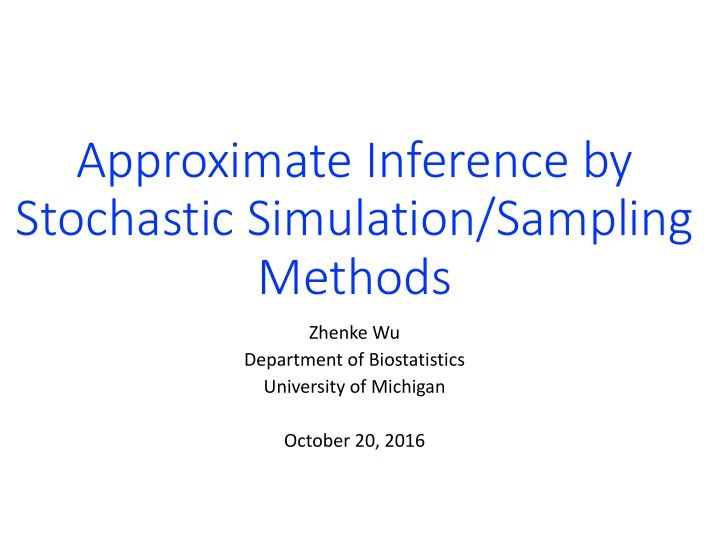

Approximate Inference by Stochastic Simulation/Sampling Methods Zhenke Wu Department of Biostatistics University of Michigan October 20, 2016
Inference Techniques • Central task of applying probabilistic models: • Evaluate the posterior: 𝑞(𝑎 ∣ 𝑌 &'( ) • Exact Inference Algorithms • Variable elimination • Message-passing (sum-product, max-product) • Junction-Tree algorithms • Approximate Inference • To overcome the exponential (of graph treewidth) computational/space complexity for exact inference algorithms 10/20/16 1
Approximate Inference Techniques • Stochastic approximation • Given infinite computational resources, they can generate exact results; the approximation arises from the use of a finite amount of processor time • Monte Carlo • Buffon’s needle; • Direct sampling (Box-Muller for bivariate Gaussian; Inverse Transformation) • Popular ones: Rejection sampling; Slice sampling; Likelihood weighting • Markov Chain Monte Carlo: Metroplis-Hastings sampling (Metropolis N, Rosenbluth AW, Rosenbluth, Teller AH, Teller E (1953), • Equation of State Calculations by Fast Computing Machines, The Journal of Chemical Physics ); Extended by Hastings WK (1970) Biometrika . Gibbs sampling (Geman and Geman, 1984), etc. • • Hamiltonian Monte Carlo • Scalable Bayesian algorithms: Parallel and distributed MCMC (research frontier; e.g., Scott SL et al. 2013, consensus Monte Carlo) • Need to address: • How to draw samples? • How to make efficient use of the obtained samples? • When to stop? 10/20/16 2
Approximate Inference Techniques • Deterministic approximation (later lectures) • Scale well to large applications, natural language processing (Blei et al. (2003) JMLR, latent Dirichlet allocation); image processing • Based on analytic approximations to the posterior distribution, for example, assume specific factorization, or parametric form such as Gaussian (work with a smaller class of distributions that are close to the target) • Loopy belief propagation • Mean field approximation • Expectation propagation • … 10/20/16 3
Monte Carlo 1. Get expectation that is difficult to calculate 10/20/16 4
Markov chain Monte Carlo 2. Construct correlated samples that explore target distribution. 10/20/16 5
Example: Bivariate Gaussian 10/20/16 6
Bivariate Gaussian 10/20/16 7
Gibbs Sampler 10/20/16 8
Simple Gibbs Sampler First 50 Samples; Rho=0.995 10/20/16 9
Slice Sampler First 50 samples; Rho=0.995 10/20/16 10
Gibbs Sampler on Rotated Coordinate Rho=0.995 10/20/16 11
Lessons Learned • Re-parametrize the model or de-correlate posterior shape when possible • The covariance structure of the posterior density guides improvement of MCMC algorithm • In WinBUGS, first 5,000 samples should not be used for inference: they are used to explore posterior shape and to tune proposal parameters 10/20/16 12
Hamiltonian Monte Carlo (HMC) First 50 samples; Rho=0.995 10/20/16 13
Hamiltonian Monte Carlo (HMC) • Computing core of Stan http://mc-stan.org/ • Advantage • Super fast • Cross-platform • Has algorithms to determine the number of leapfrog steps (No-U-Turn sampler) • Limitation • Does not support sampling discrete parameters (no associated gradient required for sampling algorithm) • Can trick Stan to do the job in some parametric models 10/20/16 14
Comments • A good posterior sampling algorithm is the one that • Use maximal information from the posterior terrain • Bold but wise explorations • Play with the code: https://github.com/zhenkewu/demo_code • Chapter 11, Bishop CM (2007) Pattern Recognition and Machine Learning. 10/20/16 15
Recommend
More recommend